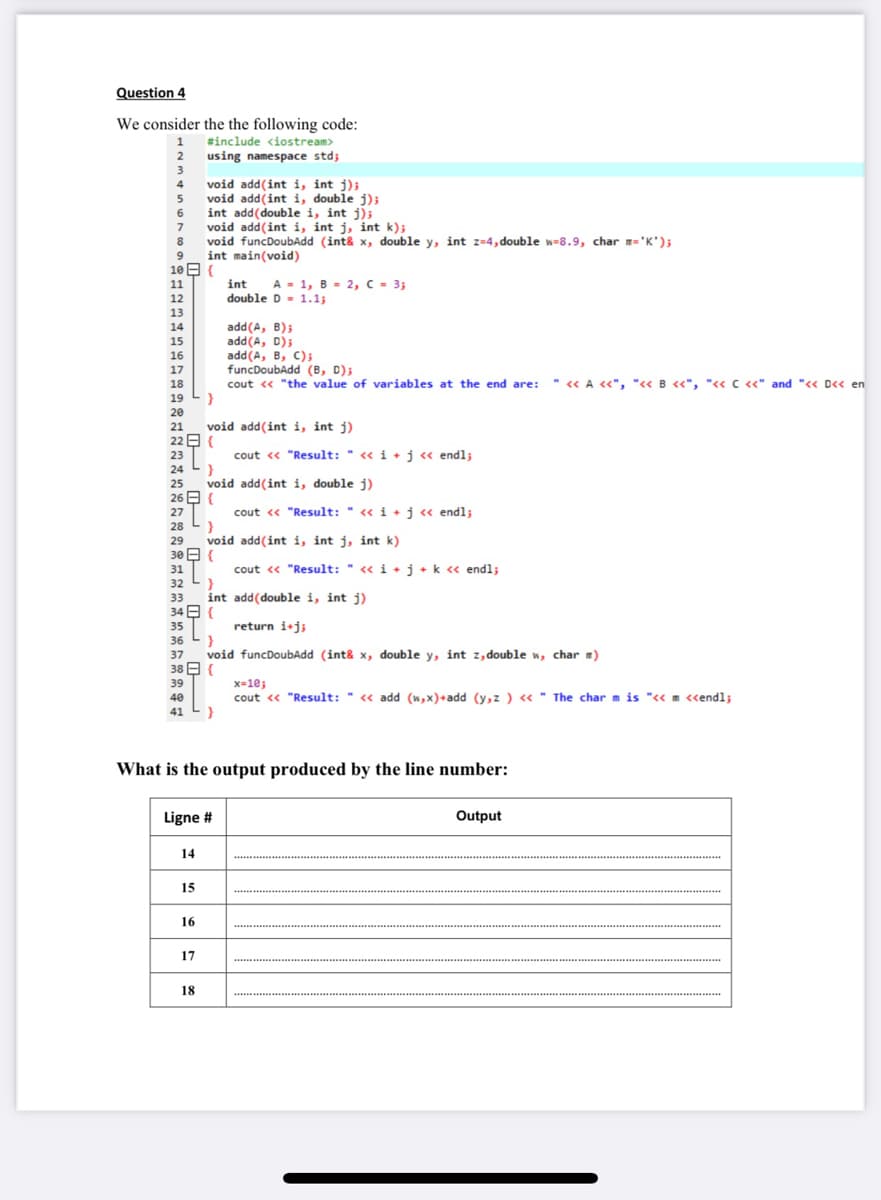Question 4 We consider the the following code: #include using namespace std; void add(int i, int i); 5 void add(int i, double j); int add(double i, int j); void add(int i, int j, int k); void funcDoubAdd (int& x, double y, int z=4, double w-8.9, char m='K'); int main(void) 10 E { int double D = 1.1; 6 8 11 A = 1, B = 2,C - 3; 12 13 add(A, B); add(A, D); add(A, B, C); funcDoubAdd (B, D); 14 15 16 17 18 cout « "the value of variables at the end are: " « A «", "« B «", "<« C «" and "« D« en 19 20 void add(int i, int j) 22 E { 21 23 cout « "Result: " « i +j« endl; 24 void add(int i, double j) 26日{ 25 27 cout « "Result: " « i +j « endl; 28 void add(int i, int j, int k) 30 E { 29 cout « "Result: " « i +j+k « endl; } 31 32 33 int add(double i, int j) 34E { 35 return i+j; 36 37 void funcDoubAdd (int& x, double y, int z,double w, char m) 38 9 { 39 x=10; cout « "Result: " « add (w,x)+add (y,z ) « " The char m is "<« m <
Question 4 We consider the the following code: #include using namespace std; void add(int i, int i); 5 void add(int i, double j); int add(double i, int j); void add(int i, int j, int k); void funcDoubAdd (int& x, double y, int z=4, double w-8.9, char m='K'); int main(void) 10 E { int double D = 1.1; 6 8 11 A = 1, B = 2,C - 3; 12 13 add(A, B); add(A, D); add(A, B, C); funcDoubAdd (B, D); 14 15 16 17 18 cout « "the value of variables at the end are: " « A «", "« B «", "<« C «" and "« D« en 19 20 void add(int i, int j) 22 E { 21 23 cout « "Result: " « i +j« endl; 24 void add(int i, double j) 26日{ 25 27 cout « "Result: " « i +j « endl; 28 void add(int i, int j, int k) 30 E { 29 cout « "Result: " « i +j+k « endl; } 31 32 33 int add(double i, int j) 34E { 35 return i+j; 36 37 void funcDoubAdd (int& x, double y, int z,double w, char m) 38 9 { 39 x=10; cout « "Result: " « add (w,x)+add (y,z ) « " The char m is "<« m <
Computer Networking: A Top-Down Approach (7th Edition)
7th Edition
ISBN:9780133594140
Author:James Kurose, Keith Ross
Publisher:James Kurose, Keith Ross
Chapter1: Computer Networks And The Internet
Section: Chapter Questions
Problem R1RQ: What is the difference between a host and an end system? List several different types of end...
Related questions
Question

Transcribed Image Text:Question 4
We consider the the following code:
#include <iostream>
using namespace std;
void add(int i, int i);
5
void add(int i, double j);
int add(double i, int j);
void add(int i, int j, int k);
void funcDoubAdd (int& x, double y, int z=4, double w-8.9, char m='K');
int main(void)
10 E {
int
double D = 1.1;
6
8
11
A = 1, B = 2,C - 3;
12
13
add(A, B);
add(A, D);
add(A, B, C);
funcDoubAdd (B, D);
14
15
16
17
18
cout « "the value of variables at the end are:
" « A «", "« B «", "<« C «" and "« D« en
19
20
void add(int i, int j)
22 E {
21
23
cout « "Result: " « i +j« endl;
24
void add(int i, double j)
26日{
25
27
cout « "Result: " « i +j « endl;
28
void add(int i, int j, int k)
30 E {
29
cout « "Result: " « i +j+k « endl;
}
31
32
33
int add(double i, int j)
34E {
35
return i+j;
36
37
void funcDoubAdd (int& x, double y, int z,double w, char m)
38 9 {
39
x=10;
cout « "Result: " « add (w,x)+add (y,z ) « " The char m is "<« m <<endl;
}
40
41
What is the output produced by the line number:
Ligne #
Output
14
15
16
17
18
Expert Solution
This question has been solved!
Explore an expertly crafted, step-by-step solution for a thorough understanding of key concepts.
Step by step
Solved in 2 steps

Recommended textbooks for you

Computer Networking: A Top-Down Approach (7th Edi…
Computer Engineering
ISBN:
9780133594140
Author:
James Kurose, Keith Ross
Publisher:
PEARSON

Computer Organization and Design MIPS Edition, Fi…
Computer Engineering
ISBN:
9780124077263
Author:
David A. Patterson, John L. Hennessy
Publisher:
Elsevier Science

Network+ Guide to Networks (MindTap Course List)
Computer Engineering
ISBN:
9781337569330
Author:
Jill West, Tamara Dean, Jean Andrews
Publisher:
Cengage Learning

Computer Networking: A Top-Down Approach (7th Edi…
Computer Engineering
ISBN:
9780133594140
Author:
James Kurose, Keith Ross
Publisher:
PEARSON

Computer Organization and Design MIPS Edition, Fi…
Computer Engineering
ISBN:
9780124077263
Author:
David A. Patterson, John L. Hennessy
Publisher:
Elsevier Science

Network+ Guide to Networks (MindTap Course List)
Computer Engineering
ISBN:
9781337569330
Author:
Jill West, Tamara Dean, Jean Andrews
Publisher:
Cengage Learning

Concepts of Database Management
Computer Engineering
ISBN:
9781337093422
Author:
Joy L. Starks, Philip J. Pratt, Mary Z. Last
Publisher:
Cengage Learning

Prelude to Programming
Computer Engineering
ISBN:
9780133750423
Author:
VENIT, Stewart
Publisher:
Pearson Education

Sc Business Data Communications and Networking, T…
Computer Engineering
ISBN:
9781119368830
Author:
FITZGERALD
Publisher:
WILEY